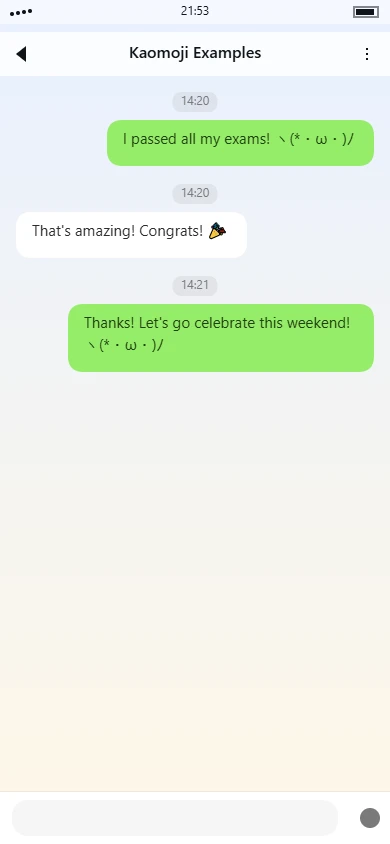( ´ ▽ ` ) kaomoji meaning | usage tips

Overview
This kaomoji ( ´ ▽
) presents a cheerful facial expression with distinctive rounded cheeks that frame a simple upward-curving mouth. The overall structure uses parentheses as the face outline, with the left parenthesis ( opening the face and the right parenthesis ) closing it. Inside this facial frame, the apostrophe characters ´ andThe character composition relies on a combination of punctuation marks and geometric symbols to construct the facial features. The apostrophes are positioned at an angle that suggests plump cheeks, a common technique in Japanese-style kaomoji to convey cuteness or contentment. The triangular character ▽ serves as a stylized mouth, its downward-pointing shape contrasting with the upward curve suggested by the overall arrangement. This creates a visual tension that reads as a gentle, contained smile rather than an exaggerated grin.
Symbol Breakdown
- Parentheses ( ): Form the basic oval shape of the face, providing containment for the internal features
- Apostrophes ´ `: Create the distinctive cheek elements, with the left apostrophe tilted upward and the right one downward to suggest three-dimensional form
- Triangle ▽: Serves as the mouth element, its geometric simplicity contrasting with the organic curve of the face outline
- Spacing arrangement: The careful placement of characters creates balanced white space that contributes to the peaceful expression
Emotion & Aesthetic Analysis
This kaomoji conveys a contented, gentle happiness that is more subdued than overt excitement. The rounded cheeks suggest a slight puffiness that often accompanies genuine smiles, while the triangular mouth provides a geometric counterpoint to the organic face shape. The expression falls somewhere between neutral contentment and mild amusement, making it suitable for situations where stronger emotions like laughter or surprise would be inappropriate.
Compared to similar happy kaomoji, this version has a more constructed, almost architectural quality due to the geometric mouth and precisely placed cheek markers. It lacks the fluidity of kaomoji that use curved characters for the mouth, instead offering a stylized representation that feels deliberate and composed. The emotional tone is consistent and reliable rather than dynamic or explosive, making it well-suited for acknowledging pleasant moments without overwhelming emphasis.
Tag categories
Use tags to quickly understand this kaomoji.
Usage guide
Usage Guide for ( ´ ▽ ` )
The kaomoji ( ´ ▽ ` ) is one of the most versatile and widely used emoticons in Japanese-inspired online communication. It features a simple face with upturned eyes and a cheerful, slightly mischievous smile that conveys a range of positive emotions from pure happiness to playful teasing. This emoticon is particularly popular in casual chats, social media comments, gaming communities, and friend group conversations where its lighthearted tone helps maintain a friendly atmosphere. The expression sits somewhere between a genuine smile and a cheeky grin, making it suitable for sharing good news, responding to jokes, or simply showing that you're in a good mood without being overly enthusiastic.
Common Use Cases
- Responding to a friend's funny story in a group chat
- Reacting to someone sharing good news or an achievement
- Adding a playful tone when teasing a close friend gently
- Expressing satisfaction after completing a task or winning a game
- Showing appreciation for a cute photo or pet picture shared online
- Lightening the mood during casual conversations with colleagues
- Accompanying a humble brag about your own accomplishments
- Reacting to food pictures or restaurant recommendations
- Expressing cheerful agreement with someone's opinion
- Adding warmth to thank-you messages among friends
- Celebrating small victories in gaming or hobby communities
- Softening requests to make them sound less demanding
Example Conversations
-
Friend sharing news
A: Just got promoted at work! 🎉 B: That's amazing! So proud of you ( ´ ▽ ` )
-
Casual planning
A: Want to grab dinner tomorrow? B: Sure! I know a great place ( ´ ▽ ` )
-
Gaming context
A: Finally beat that impossible level B: Nice! Told you you could do it ( ´ ▽ ` )
-
Social media interaction
Post: My cat learned to high-five today Comment: That's the cutest thing I've seen all week ( ´ ▽ ` )
-
Workplace casual chat
A: Thanks for helping with that presentation B: No problem! It was fun working together ( ´ ▽ ` )
-
Sharing excitement
A: The concert tickets just went on sale B: Getting mine right now! So excited ( ´ ▽ ` )
Important Notes
- Avoid using this emoticon in formal emails, professional correspondence, or serious discussions where its playful tone might seem inappropriate or unprofessional
- While generally positive, the slightly mischievous nature of the smile could occasionally be misinterpreted as sarcasm in certain contexts, so be mindful of your relationship with the recipient
- This kaomoji works best in established casual relationships rather than initial conversations with strangers
- The expression tends to be more common in text-based communication among younger demographics and anime-influenced communities
- Consider the platform norms - it's perfectly at home in Discord, Twitter, and casual messaging apps, but might stand out in more formal business communication tools
Cultural Note: This particular kaomoji style originated in Japanese online communities and has been widely adopted globally. The upward-curving eyes (▽) are characteristic of many Japanese emoticons and convey a sense of happiness and contentment that transcends language barriers, making it universally understandable in digital communication.
Usage examples
Real conversation samples that feature this kaomoji.

Example 1

Example 2
Related kaomoji
You might also enjoy these kaomoji.